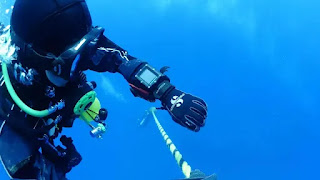THE AQUATIC ENVIRONMENT
The surface of the
earth is made by 72% of water
85% of the oxygen is
produce by the marine plants
The oceanic plant
production is 10 times more the on land
The salinity of the
ocean is about 3.5%
Water need to be
present on land for the plant to make photosynthesis
TEMPERATURES
There are water layers
in the sea or lakes, the warmer water is on the top with colder water under.
Theses layers of water are called Thermoclines
Cold water sinks under
warm water
The average temperature
of the ocean is 1C.
CURRENTS
The main currents in
the northern hemisphere flow clockwise with the clock
The main currents in
the southern hemisphere flow anticlockwise against the clock
HOW FAST THE CURRENT
FLOWS:
- 1 NAUTICAL MILE = 1852 METRES
- So the speed of one knot is 0.5 per second
- 1852/3600seconds = 0.5 knot
- If an object float 9 meters in 60 seconds,
the current speed is 0.15knot per second
- You should never enter in water with 1
knot (1meter per second)
- To check if current is present, you must
jump in the water with mask and fins
- Look at the fishes on the bottom; they
always swim against the current.
- Look also at the mooring, if current is
present, it will be a stream of water in the back of the buoy.
LONGSHORE CURRENT
- Flow parallel to the shore
RIP CURRENT
- Is a current who takes you away from the
shore
RIP TIDES
- Tides who takes you away (if tide is
ebbing ,Down) or to the reef (if tide is flooding , up)
If the current push
you down, the best is to hold on to the reef.
If the current push
you up, the best is to hold on to the reef
If you get push away
from the reef, there is less current in deep water and it will be easier to
ascent.
The tides are caused
by the moon and the sun position with bigger impact from the moon
The best time to dive
is when the tide is high and not moving (slack tide)
WAVES
- Waves are cause by wind
- The highest point of a wave is the crest
- The lowest point of the wave is the trough
- The distance between 2 crests is the
wavelength
- How high are the waves is the height
- Waves break when the depth of the water is
the same as the height of the wave
- The place where the waves break is the
surf zone
- It is always good to observe the waves for
5 to 15 minutes to see their pattern
- Normally it is always 7 big waves and small
BOTTOM TOPOGRAPHY
- Is how the underwater terrain look like
TAXONOMY
- Is the science who organize the plants and
animals in group
PHYTOPLANKTON
- Is plant that are tiny and nearly invisible,
and are 995 of the plant production in the sea
- 2 major groups of phytoplankton are :
- the dinoflagellates
- diatom
- when dinoflagellates blooms, they produce
red tides killing reef fishes who cannot pump O2 from the water and they
are bioluminescent
- some dinoflagellates produce toxin who
are not dangerous for the mollusk who eat them but are poisonous for
human who eat them (paralytic shellfish poisoning.
- Diatom in the other hand produce
siliceous shell which we use in toothpaste and filters.
- Toothpaste remove scratches
MARINES ANIMALS
·
PROTOZOA :
mean first animal. They are the zooplankton of the sea.(KRILL FOR THE WHALE
SHARK AND MATA RAYS
·
INVERTABRATE
: with no backbone :
·
SPONGES :
they can be recognize with their holes who filter water from the inside out
·
STINGING
ANIMALS : jellyfishes like Portuguese man-of-war, box jelly, fire coral, some
anemones ,sea fan, sea pen are in this family. With stinging tentacles
·
CORAL REEF
: it requires water temperature from 20C to leave with 22C average. The coral
need a symbiotic relation with algae to give him O2. Algae have a place to leave and the coral
benefit from them. The algae give the coral it color. Corals are colonial form,
with a coral reef containing many millions of individual anemone-like animals
They are made by
calcium carbonate that is their skeleton structure. Only
The top of the coral
are leaving creatures. Biorock
explaination
·
MARINE WORMS :fireworm can sting
with their air-like, Christmas worm and flat worm are the most famous.
·
SOFT
BODIED ANIMALS : shells, oysters, squid, octopus, are part of this group
·
ARTHROPOD
: shrimps, crabs, lobster are part of this group
·
VERTEBRATE
: with backbone :
·
Fish,
shark, stingray, are part of this group
·
TURTLES SEA SNAKES MARINES MAMMALS
·
NEVER RIDE
A TURTLE.
·
Sea snakes
are very poisonous but not aggressive
·
CETACEAN:
whales, dolphins are part of this group








